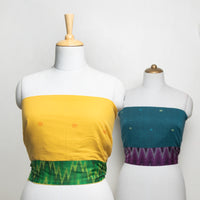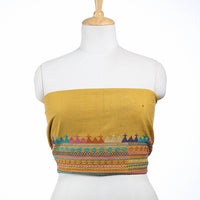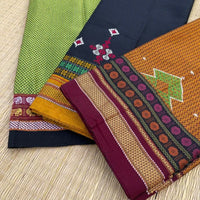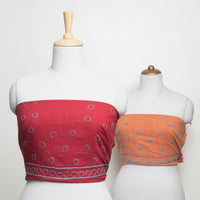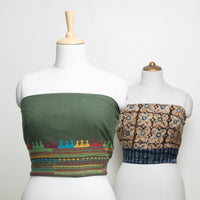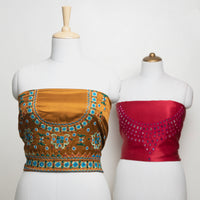What Is Kalamkari?
Kalamkari, which literally translates to "pen-worked," is a multi-step design method. The fabric is first made stiff by steeping it in astringents and buffalo milk, and it is then sun-dried. The designs' red, black, brown, and violet components are highlighted using a mordant, and the fabric is then submerged in an alizarin solution. The material is immersed in an indigo wash and wax all over except for the areas that will be dyed blue. The wax is then removed, and the portions that need to be yellow or light green are manually painted.
It is a kind of cotton cloth that has been hand-painted or block-printed and is made in areas of Iran and India. Its name, which means "drawing with a pen," is Persian in origin and comes from the terms "qalam" (pen) and "kari" (craftsmanship). In the seventeen-step process of kalamkari, only natural colours are employed.
Earthy colours like indigo, mustard, rust, black, and green are frequently used in kalamkari art. Natural sources are used to extract the dyes, which are then employed to create the colours of Kalamkari artwork without the use of chemicals or artificial materials. For instance, artisans create black colour by mixing iron filings, water, and jaggery, which they primarily use to outline sketches. Pomegranate peels can be used to make mustard or yellow dyes by boiling them, but madder or algirin bark can be used to make red dyes. The same is true for blue, which comes from indigo, and green, which is created by combining yellow and blue.
Unique Type Kalamkari Print Blouse Piece Available at iTokri
Kalamkari Blouse Piece, available at iTokri, adds a distinctive and artistic touch to any ethnic clothing. Here are some style ideas and recommendations for making the best use of this distinctive piece:
Wear the Kalamkari pattern blouse alongside a solid saree or ensemble in a complimentary hue. Make sure the saree or blouse compliments the colours of the Kalamkari design. Choose traditional draped styles, such as the Nivi drape, for a timeless and exquisite look.
Pair the Kalamkari pattern shirt with an updated silhouette, such as a maxi skirt or palazzo trousers, to create a fusion combination. Try combining designs by wearing the blouse with a modest, complementing print for a fashionable and diverse appearance. To boost the suit, add modern accessories such as striking earrings, a hefty bracelet, or a waist belt.
Pair the Kalamkari pattern shirt with various bottoms such as plain skirts, pants, or even jeans for a casual-chic appearance. Contemplate putting the blouse across a solid-coloured blouse or skirt to highlight the detailed design and add interest to your ensemble.
iTokri Has Great Range Of Kalamkari Work Products
One of India's oldest arts, kalamkari is renowned for its extraordinarily exquisite hand paints on textiles. This is a fairly common handspring used in fabrics for clothing such as sarees, ready-to-wear salwar kameez, kurtas, etc. The most prevalent topic is depicting spectacular paintings of sun chariots, well-known deities, and events from the Ramayana and Mahabharata epics.
The exquisite skill of Indian craftsmen is displayed in kalamkari sarees, Kalamkari cotton blouse piece, and kalamkari blouse material is the ideal fusion of style and tradition, followed by contemporary trends. There is a large selection of Kalamkari blouse fabric available in various patterns and kalamkari fabrics at iTokri. Due to the use of natural dyes and hues, they do not fade when washed and it is one of the best qualities of kalamkari blouse material at iTokri.
For women seeking style and refinement, kalamkari blouses are ideal. Want to get the best kalamkari blouse piece price? iTokri is your destination. The Kalamkari patterns add a distinctive style to both cotton and silk. Block-printed kalamkari blouse pieces online at iTokri made of kalamkari silk are comfortable and easy to wear. Buy a Kalamkari blouse online at iTokri at an affordable price. Apart from the kalamaki work blouse you can also discover here kalamkari fabric, kalamkari printed kurtis, kalamkari work kaftans, klamkari sarees, kalamkari dress material, kalamkari dupattas, and kalamkari stoles.
Why Should You Shop From iTokri?
iTokri's mission is to build a creative and cutting-edge network that promotes indigenous Indian artists. Thousands of individuals all across the world have been delighted by iTokri's efficient and timely delivery services. Its objective has helped it build a clientele that it values tremendously. With the amazing collection and variety of numerous handcrafted products iTokri is the number one choice for anyone who loves handicraft products.
FAQs
Why are kalamkari blouses famous?
Kalamkari blouse styles were quite popular in mediaeval India. These patterns not only stylishly portrayed legendary tales, but they also featured high-quality embroidery that was formerly reserved for royalty.
Can a kalamkari blouse be worn with any fabric or saree?
It is not a well-established rule that kalamkari should be worn with sarees as a stand-alone cotton blouse. You might also try them with other pretty fabrics to see how wonderful they become. Shop for Kalamkari blouse piece online at iTokri and get the finest fabric delivered to your doors.
How to wash a kalamkari work blouse?
You can hand wash kalamkari work blouse to avoid any fading of the fabric.










